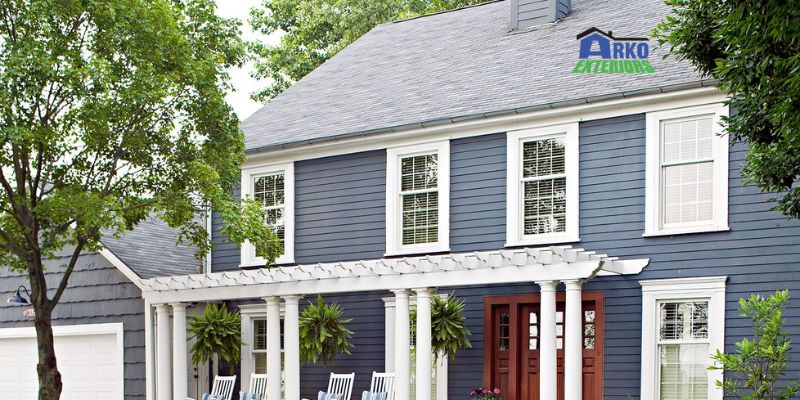Choosing the right siding material for your home is an important decision that can significantly impact your home’s overall look, feel and functionality. With so many options available, it can be difficult to know where to start. Before making a final decision on a material, it’s crucial to consider factors such as durability, cost and aesthetics.
Here’s what to consider when thinking about new siding for your home…
#1 Consider Durability & Maintenance:

Different siding materials have varying levels of durability and maintenance requirements. For example, vinyl siding is known for being low maintenance and durable, while wood siding requires more maintenance and may be more prone to rot and insect damage.
Consider the climate in your area and the overall style of your home when choosing a siding material. For example, in areas with high winds or frequent storms, you may want to consider a more durable and impact-resistant siding material like fiber cement or metal.
It’s also important to consider the maintenance requirements of each material. Some siding materials require regular painting or staining, while others may only require occasional cleaning. Make sure you choose a siding material that you’re willing and able to maintain properly to keep it looking great and functioning well.
#2 Evaluate Cost & Aesthetics:

Siding materials vary widely in cost, so it’s important to choose a material that fits within your budget. Vinyl and aluminum siding are typically more affordable options, while wood and fiber cement tends to be more expensive.
Consider the overall aesthetics of your home when choosing a siding material as well. Some materials, like wood and cedar, have a natural, rustic look that may be perfect for a country-style home. Other materials, like stucco or stone veneer, may be better suited to a more modern or contemporary home.
Ultimately, choosing the right siding material involves balancing durability, maintenance, cost and aesthetics to find a material that will provide both practical and aesthetic benefits for your home.
#3 Consider Energy Efficiency:
Siding materials can also impact the energy efficiency of your home. Some materials, like vinyl and insulated siding, offer better insulation and can help reduce energy costs by keeping your home cooler in the summer and warmer in the winter. This can be especially important in areas with extreme temperatures.
If energy efficiency is a top priority for you, consider choosing a siding material with a higher R-value, which is a measure of its thermal resistance. Look for materials with features like insulation, vapor barriers or reflective coatings to improve energy efficiency.
#4 Evaluate Environmental Impact:
If sustainability is important to you, it’s also worth considering the environmental impact of different siding materials. Some materials, like wood, are renewable and biodegradable, while others, like vinyl, can be difficult to recycle and may release harmful chemicals during manufacturing and disposal.
Look for siding materials that are made from sustainable, environmentally friendly materials and are produced using sustainable manufacturing practices. Some options to consider include reclaimed wood, recycled metal or fiber cement made from natural materials like sand and cellulose fibers.
#5 Evaluate Long-Term Value:
It’s important to consider the long-term value of the siding material you choose. While some materials may be more expensive upfront, they may offer better long-term value due to their durability and low maintenance requirements.
For example, fiber cement siding is more expensive than vinyl siding, but it is also more durable and requires less maintenance over time, which can save you money in the long run. Additionally, higher-end siding materials like stone or brick can add significant value to your home and may be worth the investment if you plan to sell your home in the future.
#6 Look For Installation Warranties:
When choosing a siding material, it’s important to consider the warranty and installation process. Look for siding materials that come with a warranty to protect you against defects or damage over time. Additionally, make sure you work with a reputable contractor who has experience installing the specific type of siding you choose to ensure proper installation and avoid potential issues down the line.
#7 Consider The Style Of Your Home:
The style and architecture of your home should also play a role in selecting the right siding material. Certain materials, such as cedar shake or board and batten, may be more suited to traditional or historic homes, while others, like stucco or metal, may be more appropriate for modern or contemporary homes.
Take into account the existing design features of your home, such as its color, texture and shape, when selecting a siding material. This will ensure that the new siding complements and enhances the existing aesthetic.
#8 Think About Maintenance Requirements:
Different siding materials have varying maintenance requirements, so it’s important to consider how much time and effort you are willing to put into maintaining your siding over time. Some materials, like vinyl or aluminum, require little to no maintenance, while others, like wood or brick, may require regular cleaning or sealing to keep them looking their best.
Consider your lifestyle and how much time you have to dedicate to maintaining your siding before making a final decision. If you prefer a low-maintenance option, look for materials that are durable and require minimal upkeep.
Summary:
In conclusion, choosing the right siding material for your home requires careful consideration of various factors such as durability, cost and aesthetics. By weighing the pros and cons of each material, you can make an informed decision that best suits your needs and preferences. Remember to also consider the climate and environmental conditions in your area to ensure that your siding can withstand the elements. Ultimately, investing in the right siding material will not only enhance the appearance of your home but also protect it from damage and potentially save you money in the long run.

